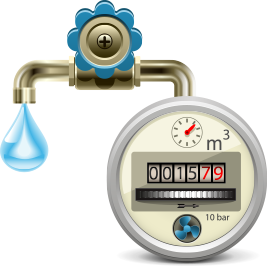 High water meter reading
High water meter reading
Residents are encouraged to monitor their own water consumption regularly. Monitoring your water meter will alert you to any changes in your water consumption and may assist you in identifying if you have a leak on the property.
If the water usage at your property is higher than anticipated and you are concerned regarding the increase, Council suggests that you undertake a Water Meter Leakage Test (as described below) to establish if there is a water leak on the property.
How to Read and Perform a Leakage Test on a Water Meter
To read a water meter:
- Identify where the water meter for your property is located.
- Carefully open the water meter box lid and remove any obstructions..
- Read the digits on the water meter (note some water meters have a small lid to flip to reveal the digits). Read the digits from left to right.
- Please note that the black digits indicate kilolitres and red digits indicate litres (please ignore the 4th red digit if present). 1000 litres equals 1 kilolitre.
It is the property owners’ responsibility to keep the water meter boxes free from debris, grass, garden mulch, soil, other obstacles and clear of gardens, fences and earthworks.
To test a water meter:
- To ensure the accuracy of the Leakage Test, turn OFF all internal and external taps and fixtures (leaving the stopcock at the water meter switched ON). Ensure toilet cistern and hot water systems are left ON.
- Record the reading on the water meter (all black and red digits).
- Don't use any water (no flushing of toilets or turning on of any taps) for at least 4 hours (although overnight is recommended). If a 4 hour period is not possible or is inconvenient, then a test over 2 hours is usually adequate.
- After the end of the test period, check the water meter again and record the reading (all black and red digits).
If the reading has changed (even only a slight shift in the red dial furthest to the right), it indicates that there may be a water leak within the property.
If a leak is identified on your property
If a loss of more than one (1) litre per hour is recorded, you should check for dripping taps, faulty toilet cisterns or other forms of leakage. Any loss of more than 10 litres per hour is very significant and should be promptly investigated.
The owner/resident should contact a licensed plumber to locate and repair the leak.
It is important to note that the property owner is responsible for the water infrastructure on the property side of the water meter. This includes the repairs of any leaks in pipes or fixtures.
Please note that the Plumbing and Drainage Regulation 2019 states that all repair work classified as ‘Notifiable Work’ must be undertaken by a licensed plumber. Please contact Council for information on repair work that is classified in this category.
The following repairs that are listed under ‘Schedule 3 Unregulated Work’ of the Plumbing and Drainage Regulation 2019 are permitted to be performed by individuals other than a licensed plumber;
- Replacing a shower head or domestic water filter cartridge
- Replacing a jumper valve or washer in a tap
- Repairing or replacing a drop valve washer, float valve washer or suction cup rubber in a toilet cistern
- Replacing caps to ground level inspection openings on a sanitary drain
- Cleaning or maintaining a ground level grate for a trap on a sanitary drain
- Installing or maintaining an irrigation or lawn watering system downstream from a tap, isolating valve or backflow prevention device on the supply pipe for the watering system
- Repairing or maintaining an irrigation system for the disposal of effluent from a greywater use facility or on-site sewage facility
Unregulated work can only be carried out by the owner of the premises and not for any other property or monetary gain.
Vacant Properties – House and/or Land
If you are away from your property for extended periods of time eg. holidays, working, medical reasons or you have a vacant house, Council suggests that you turn off your water at the meter to prevent water loss that can occur due to plumbing failures during your absence.
Please refer to your manufacturer instructions for hot water systems, water coolers, air conditioners and any other appliances connected to water before turning the water off at the meter.
If you have a water meter/connection/water line on your vacant land or in an unused part of your property, Council urges that these connections/lines are monitored regularly to prevent water loss resulting from plumbing infrastructure failures.